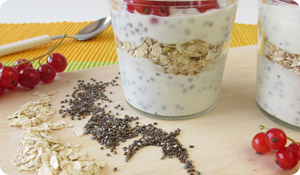
What Is Chia?
Chia, which look like tiny poppy seeds, are seeds of the plant Salvia hispanica. Chia was an important part of ancient Central American Aztec and Mayan diets. So important, in fact, that chia is the Mayan word for "strength."
Why Eat It?
Chia has plenty to offer, including:
- Fiber. Fiber is the indigestible part of plant foods and a necessary component of a healthy diet. There are two types: Soluble fiber helps slow digestion, while insoluble fiber adds bulk to your stool, helping food move quickly through the digestive tract. Because food manufacturing processes tend to remove fiber, many of us fall far short of the 20-30 grams a day recommended by the Food and Nutrition Board/Institute of Medicine of the National Academies. But consuming chia, which is high in both soluble and insoluble fiber, can help: About two tablespoons of chia seeds yields a hefty 10 grams of fiber.
- Omega-3 fatty acids. Chia seeds are actually the richest source of plant-based omega-3 fatty acids, or healthy fats. Flax and cold-water fish, such as salmon, are also good sources of omega-3s.
- Protein. Chia seeds are a complete source of protein and have twice as much protein as other grains or seeds. (Complete proteins have all 20 amino acids, the building blocks of proteins.)
- Vitamins and minerals. Chia is chock full of magnesium, calcium, boron (a trace mineral that helps calcium get in your bones), ALA (alpha-linolenic acid, a type of omega-3 fatty acid), phosphorus, manganese, copper, niacin, zinc, and iron.
- Weight loss. Because chia adds bulk to food, you’ll likely feel fuller and eat less.
Adding Chia to Your Diet
Chia seeds are versatile. Here are some easy ways to incorporate these super seeds into your diet:
- Soak chia seeds in liquids, such as milk or water. This makes them jelly-like in texture. Add sweet or savory toppings and you can make a tasty, healthy breakfast cereal or dessert pudding.
- Grind the seeds and add them to baked goods.
- Blend or stir chia into smoothies.
- Sprinkle chia on top of cereal, oatmeal, salad, or yogurt.
- Chia sprouts are also edible—try them in salads and sandwiches.
Alison Massey, MS, RD, LDN, CDE, reviewed this article.
Sources
- Janice Lipman. "Chia Seeds – Nature’s Little Powerhouse." Accessed May 30, 2014.
- "The Power of Chia Seeds." BeWellBuzz.com. June 10, 2009. Accessed May 30, 2014.
- Joseph Mercola, DO. "The Health Benefits of Fiber." November 25, 2013. Accessed May 30, 2014.
- Andrew Weil, MD. "What Is Chia?" May 15, 2006, accessed May 30, 2014.
- "What Are Chia Seeds?" Academy of Nutrition and Dietetics, April 2013. Accessed May 30, 2014.
- Norlaily Mohd Ali, Swee Keong Yeap,Wan Yong Ho, Boon Kee Beh, Sheau Wei Wan, and Soon Guan Tan. "The Promising Future of Chia, Salvia hispanica L." J Biomed Biotechnol 2012: 171956. Published online Nov 21, 2012. doi: 10.1155/2012/171956. Accessed June 19, 2014.
- "Dietary Reference Intakes: Macronutrients." Institute of Medicine of the National Academies/Food and Nutrition Board.





